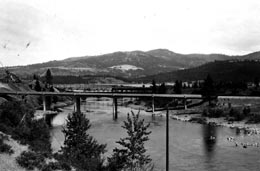On November 2, 1939, construction is completed on the Appleway Bridge, also known as the Old I-90 Bridge. Work on this $118,259 bridge project commenced on January 10 of that year and took 10 months -- 24 days past the contract time -- to complete because of high water during the summer. The bridge replaces the old Spokane Bridge and straightens out the two dangerous curves at the old bridge. It is on the route known as Appleway between Spokane and Coeur d'Alene, also known as Primary State Highway 2 and US 10. The bridge will serve as a primary crossing for almost four decades until a new Interstate 90 freeway bridge is built just upstream. The Appleway Bridge then will then serve for decades as a secondary route. Spokane County will impose weight restrictions in 2007 and will narrow traffic to two lanes. The bridge will be designated for replacement, with construction to begin in late May 2010 and a new bridge to be built by 2012.
A Border Bridge
The Appleway Bridge was first proposed in 1937 as a way to eliminate the old and dangerous Spokane Bridge not far from the same location. It was about 1,200 feet upstream of the old Spokane Bridge and crossed the Spokane River near the spot where the river crosses the Washington-Idaho border at Stateline, Idaho.
The bridge is a reinforced-concrete T-beam structure designed in an Art Deco style. The bridge is 512 feet long and 55.1 feet wide. A four-foot sidewalk on the west side is provided for pedestrians.
According to the 2009 Spokane County mitigation document, the Appleway Bridge was constructed with seven individual spans, supported by eight bent segments (piers that support a span).
"Each bent segment includes a rectangular concrete footing, with five square columns rising vertically and capped by a steel reinforced concrete cross member, which in turn supports the deck superstructure.
"Between each span is an elongated parabola (arch); a series of stepped-back concrete Art Deco nuances are placed over the span seams, continuing up to the top of the wall railing. Two deck hinges (for expansion) are located in the second and fifth spans" (Creighton).
"The side walls (railings) consist of solid concrete that overhang the superstructure by approximately four feet. The railing is topped by continuous run of miniature closed spandrels and arches, all of concrete" (Creighton).
Inscriptions
The bridge features two inscriptions on the concrete rails at the westbound approaches to the bridge, lettered in an Art Deco style. They read (downstream rail first):
Spokane River Bridge
Eastern Gateway to the State of Washington and the Spokane Valley.
Spokane River
Perpetuating the Name of the Indian Tribe Spo-Kan-EE -- Children of the Sun.
Life of a Bridge
The Appleway Bridge served as the main east-west route between Spokane and Coeur d'Alene for about 38 years. The route became known as US 10, and then, when the federal interstate highway system was established, it was used as part of Interstate 90 in the years before a restricted access freeway was completed over that stretch of the route. It is still sometimes referred to as the Old 1-90 Bridge.
The freeway, on a route that crosses the river just south of the Appleway route, was completed in 1977. This new stretch of I-90 included two modern bridges, one for each direction of travel. The bridges and freeway were dedicated on July 28, 1977, immediately rendering the Appleway Bridge a secondary route with far less traffic than before. It was subsequently turned over to Spokane County.
The Appleway Bridge was used for the next 20 years for local traffic. Progressive deterioration resulted in restricted weight on the bridge and later restriction of traffic to cars and small pickup trucks. Finally, the County designated the bridge for replacement.
In April 2010, Spokane County commissioners accepted a $6.2 million bid for a new Appleway Bridge. The old Appleway Bridge will be removed. Plans call for construction to begin at the end of May 2010. Work should be completed by spring of 2012.

